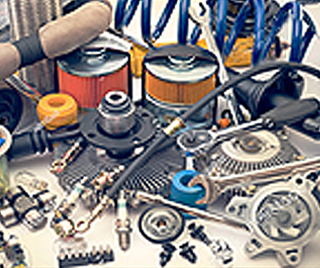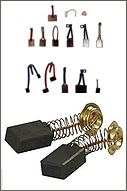
Electrical
We supply electrical spares and equipment necessary for cement plants. We are supplying brand new as well as replacement electrical parts to cement plants across the world.
 Variable Frequency Drives
A variable-frequency drive (VFD) (also termed adjustable-frequency drive, variable speed drive, AC drive, micro drive or inverter drive) is a type of adjustable speed drive used in electro-mechanical drive systems to control AC motor speed and torque by varying motor input frequency and voltage.
Variable Frequency Drives
A variable-frequency drive (VFD) (also termed adjustable-frequency drive, variable speed drive, AC drive, micro drive or inverter drive) is a type of adjustable speed drive used in electro-mechanical drive systems to control AC motor speed and torque by varying motor input frequency and voltage.
 Cables
These connecting and control cables are used in machines and plants for instrument engineering. These cables are universally applicable, resistant to many oils and chemicals and are highly flexible and sturdy. There are a wide range of flexible cables such as color coded, number coded, copper screened, steel wire braided, polyurethane cables, neoprene rubber cables, robotic cables, super flexible cables with minimum bending radius and all types of weather resistant cables.
Cables
These connecting and control cables are used in machines and plants for instrument engineering. These cables are universally applicable, resistant to many oils and chemicals and are highly flexible and sturdy. There are a wide range of flexible cables such as color coded, number coded, copper screened, steel wire braided, polyurethane cables, neoprene rubber cables, robotic cables, super flexible cables with minimum bending radius and all types of weather resistant cables.
 Attenuator
An attenuator is an electronic device that reduces the amplitude or power of a signal without appreciably distorting its waveform. An attenuator is effectively the opposite of an amplifier, though the two work by different methods. While an amplifier provides gain, an attenuator provides loss, or gain less than 1.Attenuators are usually passive devices made from simple voltage divider networks.
Attenuator
An attenuator is an electronic device that reduces the amplitude or power of a signal without appreciably distorting its waveform. An attenuator is effectively the opposite of an amplifier, though the two work by different methods. While an amplifier provides gain, an attenuator provides loss, or gain less than 1.Attenuators are usually passive devices made from simple voltage divider networks.
 Circuit Breaker
A circuit breaker is an automatically-operated electrical switch designed to protect an electrical circuit from damage caused by overload or short circuit. Its basic function is to detect a fault condition and, by interrupting continuity, to immediately discontinue electrical flow. Unlike a fuse, which operates once and then has to be replaced, a circuit breaker can be reset (either manually or automatically) to resume normal operation.
Circuit Breaker
A circuit breaker is an automatically-operated electrical switch designed to protect an electrical circuit from damage caused by overload or short circuit. Its basic function is to detect a fault condition and, by interrupting continuity, to immediately discontinue electrical flow. Unlike a fuse, which operates once and then has to be replaced, a circuit breaker can be reset (either manually or automatically) to resume normal operation.
 Insulators
An electrical insulator is a material whose internal electric charges do not flow freely, and therefore make it nearly impossible to conduct an electric current under the influence of an electric field. This contrasts with other materials, semiconductors and conductors, which conduct electric current more easily. The property that distinguishes an insulator is its resistivity; insulators have higher resistivity than semiconductors or conductors.
Insulators
An electrical insulator is a material whose internal electric charges do not flow freely, and therefore make it nearly impossible to conduct an electric current under the influence of an electric field. This contrasts with other materials, semiconductors and conductors, which conduct electric current more easily. The property that distinguishes an insulator is its resistivity; insulators have higher resistivity than semiconductors or conductors.
 Trivector Meter
The Trivector meter is a measuring instrument which measures the kW, kVAr, the kVA of a power line. These instruments can measure both power as well as energy. Trivector meters are normally used in substations and to measure the power flowing through the feeders. They are used for billing power drawn by industrial customers. The Trivector enables the simultaneous measurement of different electrical parameters which enables accurate assessment of the power consumed.
Trivector Meter
The Trivector meter is a measuring instrument which measures the kW, kVAr, the kVA of a power line. These instruments can measure both power as well as energy. Trivector meters are normally used in substations and to measure the power flowing through the feeders. They are used for billing power drawn by industrial customers. The Trivector enables the simultaneous measurement of different electrical parameters which enables accurate assessment of the power consumed.

- DC/AC Motors
- Slip Rings Motors
- Power Generators
- Welding Generators
- Crane Installation
- Electro Graphite
- Resign Bonded
- Pitch Bonded
- Copper Impregnated
- Silver & Copper Impregnated
- Graphite
- Conductive
- Soft enough to provide a good wear point against the copper segments
- Does most of the wearing away in this application
- Fairly easy to replace them
 Load Cells
A load cell consists of a metal element that is introduced to a change through tension (pulling apart) or compression (pushing together) forces, and interior strain gages that sense this change, which is sometimes referred to as deflection.
Load Cells
A load cell consists of a metal element that is introduced to a change through tension (pulling apart) or compression (pushing together) forces, and interior strain gages that sense this change, which is sometimes referred to as deflection.
 Relays
A range of manufacturing and production processes rely on current-operated relays to provide a continuously adjustable trip-current setting. They are able to protect mechanical apparatus from jam-up or other overloading conditions that result in measurable increases in motor current.
Relays
A range of manufacturing and production processes rely on current-operated relays to provide a continuously adjustable trip-current setting. They are able to protect mechanical apparatus from jam-up or other overloading conditions that result in measurable increases in motor current.